Charaka Shareera Sthana 7th Chapter Shareera Sankhya Shareeram
7th chapter of Charaka Shareera sthana deals with “the enumeration of the organs as conducive to the understanding of the human body”. The chapter name is Shareera Sankhya Shaareeram.
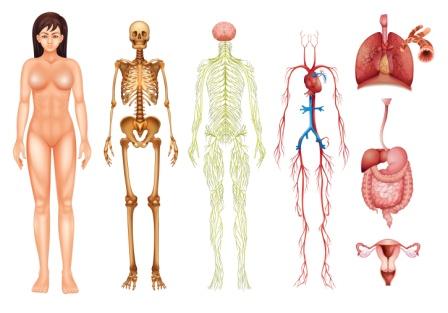
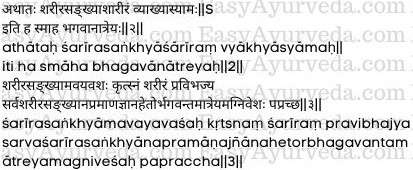
We shall now explore the chapter on “the enumeration of the organs as conducive to the understanding of the human body”. Thus said Lord Atreya [1-2]
Read – Shareera: Formation Of Human Body, Ayurvedic Concept
Table of Contents
Query about organs of body
With a view to ascertain the number and measurement of the entire body by classifying the body according to its component organs, Agnivesha asked Lord Atreya to enumerate the organs of the body. [3]
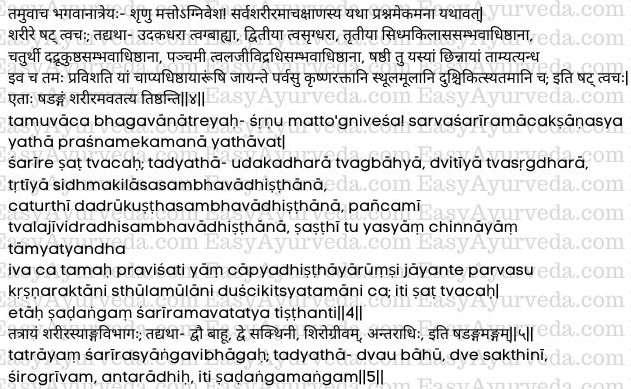
Six layers of skin
Lord Atreya replied, “Listen to meattentively O! Agnivesha! I shall describe the entire body in appropriate manner as per your questions”
There are six layers of skin as follows:
First one is the external layer which is known as Udaka-Dhara (containing / made up of watery substance of Lymph).
The second layer is Asrgdara (containing blood, capillaries)
The third layer is the site for the manifestation of Sidhma (a type of determatosis) and Kilasa (Leucoderma)
The fourth layer is the site for the manifestation of Dadru (ring-worm) and Kustha (obstinate skin diseases including leprosy)
The fifth Layer is the site for the manifestation of Alaji (boil) and Vidradhi (abscess).
The sixth layer is that by the excision of which the individual gets trembling and enters into darkness (gets fainting) like a blind man. In this layer the boils manifest in the joints which are blackish red in colour and are deep rooted. Such boils are extremely difficult of treatment. These are the six layers of the skin by which the entire body along with its six organs (parts) remain covered. [4]
Read – Signs Of Good Skin Health (Twak Sara Purusha Lakshanas)
Parts of the body
The body is divided into six parts, viz. Two upper limbs, head including neck and the trunk. (These are the six parts of the body). [5]
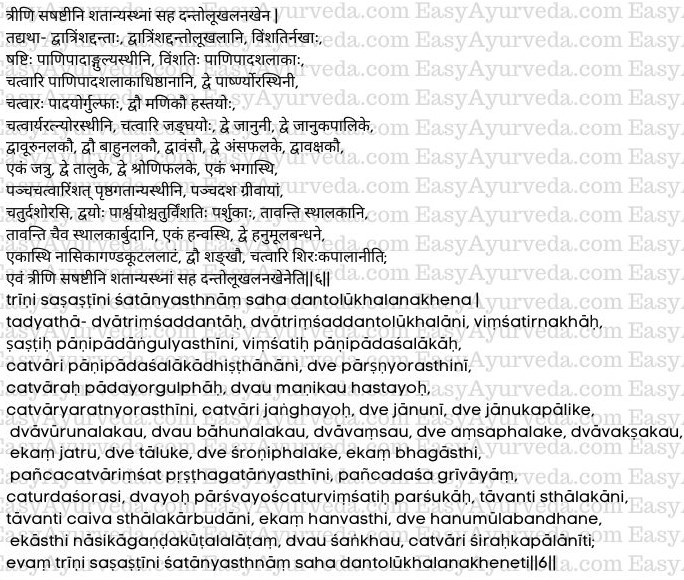
Number of bones
Along with teeth, sockets of teeth and nails, bones in the body are 360 in number. They are as follows:
Teeth- 32
Sockets of teeth- 32
Nails – 20
Phalangeal bones of hands and feet- 60
Meta phalangeal bones of hands and feet- 20
Six bones which from the base to support the meta phalangeal bones of hands & feet- 4
Parshni (bones of heels or calcaneus)-2
Gulpha (ankle bones) – 4
Mani (wrist bones) – 2
Aratni (bones of forearms) – 4
Jangha (bones of legs) – 4
Janu (bones of knees) – 2
Janu Kapala (knee caps) -2
Hollow bones of thighs (femurs)-2
Hollow bones of arms (humerus) – 2
Amsa (bones of the Shoulder)-2
Amsaphalaka (shoulder blades) – 2
Aksaka (clavicles) – 2
Jatru (wind pipe) – 2
Talu (palated bones) – 2
Bhagasthi (public bone) – 2
Bhagasthi (public bone) – 1
Bones of the back – 45
Bone of the neck – 15
Bone of chest – 14
Bones of the sides (ribs) – 24
Sockets (for ribs) – 24
Tubercles in the sockets (for ribs) – 24
Hanvasthi or Jawbone (lower) – 1
Hanumula Bandhana (bones which keep the lower jaw locked up) -2
Bone constituting of cheeks and forehead – 1
Sankha (temporal bones) -2
Sirah kapala (pan shaped bones of the head) – 4
Thus the 360 bones including teeth, sockets of bones and nails are accounted for. [6]
Read – Asthi Shareera – Definition, Anatomy, Types Of Bones
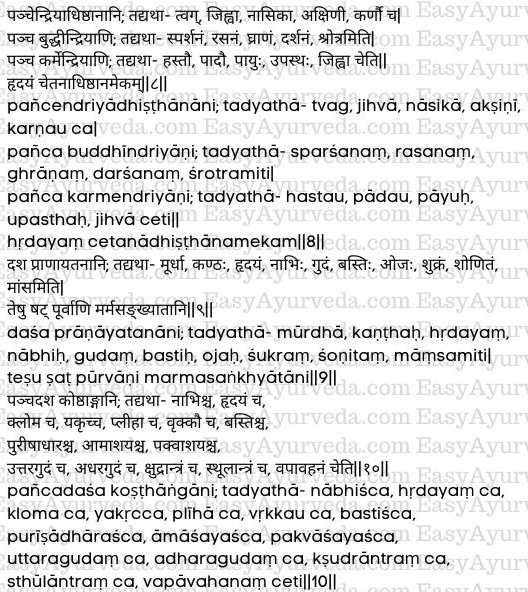
Sensory and motor organs
There are five organs of senses i.e.
- Skin
- Tongue
- Nose
- Two eyes and
- Two ears
These are five sense faculties i.e.
- Tactile
- Gustatory
- Olfactory
- Visual and
- Auditory
There are five motor organs i.e.
- Two hands
- Two feet
- Anus
- Sex organs and
- Tongue
The site of consciousness is only one, i.e. the heart. [7-8]
Resorts of life
There are ten resorts of life, viz,
- Head
- Throat
- Heart
- Umbilicus
- Anus
- Bladder
- Ojas
- Semen
- Blood and
- Flesh
Of them the first six organs are known as Marma (vital organs) [9]
Read – Involvement Of Doshas In Formation Of Organs
Visceras
Kosthangas (viscera in the thorax and abdomen) are fifteen in number. They are
- Nabhi (umbilicus)
- Hrdaya (heart)
- Kloman (lungs)
- Yakrt (liver)
- Pliha (spleen)
- Vrkkau (two kidneys)
- Basti (urinary bladder)
- Purisadhara (pelvic colon)
- Amashaya (stomach)
- Pakvashaya (colon)
- Uttaraguda (rectum)
- Adharaguda (anus)
- Ksudrantra (small intestine)
- Sthulantra (large intestine) and
- Vapavahana (omentum). [10]
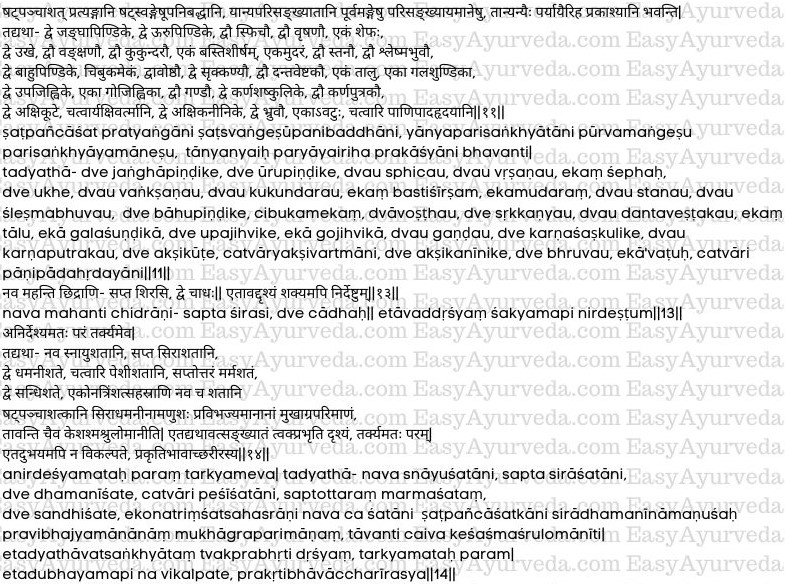
Read – Pratyangas: The minor organs, Definition, Number
Pratyangas or sub-parts of body
In the six Angas (parts of the body) there are about 56 Pratyngas (sub-parts). They were not described before while enumerating the six parts of the body. They are enumerated below following a different mode of classification:
- Janghapindika (calves) – 2
- Urupindika (muscular portion of the thigh) – 2
- Sphik (buttocks) – 2
- Vrsana (testicles) – 2
- Sepha (phallus) – 1
- Ukha (Elevations bordering axillae) – 2
- Vanksana (groins) – 2
- Kukundara (hips) – 2
- Vastisirsa (pelvis) – 1
- Udara- (abdomen) – 1
- Stana (breasts) – 2
- Slesmabhu (tonsils) – 2
- Bahupidika (muscular portion of arms – 2)
- Cibuka (chin) – 1
- Ostha(lips) – 2
- Srkkani (angles of the mouth – 2)
- Dantavestaka (gums) – 2
- Talu (Palate) – 1
- Galasundika (uvula) – 1
- Upajihvika (ear holes) – 2
- Gojhva (tongue or the organs of the ear) – 2
- Ganda (cheeks) – 2
- Karnasaskulika (ear holes) – 2
- Karnaputraka (external portion of the ear) – 2
- Aksikuta (orbit of eye) – 2
- Aksivartma (eye bids) – 4
- Aksikaninuka (medial angles of the eyes near the nose) – 2
- Bhru (eye brows) – 2
- Avatu (thyroid) – 1
- Panipadahrdaya (soles of hands and feet) – 4 [11]
Major orifices
There are nine major orifices – seven in the head and two below:
The above are the visible factors and are capable of description. [12-13]
Read – Srotas: Body Channels and Duct systems – Easy Explanation
Enumeration of other organs
Beyond what is described above can be ascertained from inference only. They are enumerated below:
- Snayu (sinew / ligaments) – 900
- Sira (veins) – 700
- Dhamani (arteries) – 200Muscles – 400
- Marma (vital parts in the body) – 107
- Joints – 200
- Terminals of the fine ramifications of the veins and arteries- 29956
- Kesha(hair), Smashru (beard and moustaches) and loma (small hair) – 2994
Tvak (skin) etc., enumerated above are properly visible and the number of the remaining can be ascertained by inference only. Both these categories do not undergo any variation during the normal state of the individual’s body. [14]
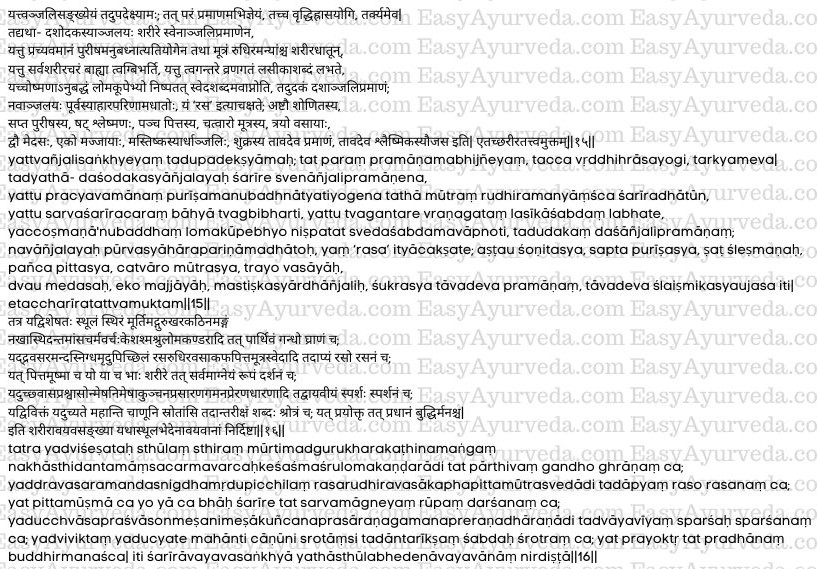
Measurement of liquid constituents of body
Substance of the body which can be measured by volume taking Anjali (space created by joining both the hands in the form of a cup) as a unit are now being described. The measurement described here pertains to the ideal standard. These substances can undergo variation in the form of increase or decrease in a normal individual and this can be ascertained by inference.
Read – Anjali Pramana: Volume Measurement As Per Ayurveda
Measurement of these substances are given below:
| Sl No | Substances | Measurement in terms of Anjali of the individual whose substances are being measured |
| 1 | Udaka (watery portion / aqueous element) a substance which is seen mixed with faeces during the occurrence of diarrhoea; it is also found in association with urine, blood, and other tissue elements of the body. It is spread all over the body with its site in the external skin. Inside the skin, it is known as Lasika (lymph) which exudes through ulcers. When the body becomes hot, it comes out from hair follicles in the form of sweat. | 10 |
| 2 | Rasa which is the first product of the ingested food after it is metabolised | 9 |
| 3 | Blood | 8 |
| 4 | Faeces | 7 |
| 5 | Kapha | 6 |
| 6 | Pitta | 5 |
| 7 | Urine | 4 |
| 8 | Vasa (muscle fat) | 3 |
| 9 | Medas (fat) | 2 |
| 10 | Majja (bone-marrow) | 1 |
| 11 | Mastiska (the fat) like substance inside the skull) | 1/2 |
| 12 | Shukra (semen) | ½ |
| 13 | Shlaismika type of Ojas | 1/2 |
Thus the various factors in the body are described. [15]
Mahabhautic predominance in various constituents
These organs are dominated by one or other of the Mahabhutas. Their specific characteristics are given below:
| Sl No | Mahabhautika predominance | Respective organs with their specific characteristics | |
| 1 | Parthiva (dominated by Prthvi Mahabhuta – earth element) | 1 | Organs which are gross, stable, having forms, heavy, rough and hard like nail, bone, teeth, flesh, skin, faeces, hair, smasru (moustache) |
| 2 | Smell (of the body) and | ||
| 3 | Olfactory faculty | ||
| 2 | Apya (dominated by Jala Mahabhuta – water element) | 1 | Factors in the body which are liquid, mobile, slow, unctuous, soft and slimy like Rasa (Plasma), Rudira (blood), Vasa (muscle fat), Kapha, pitta, urine and sweat |
| 3 | Gustatory faculty | ||
| 3 | Agneya (dominated by Agnimahabhuta – fire element) | 1 | All factors like pitta, temperature and lustre of the body |
| 2 | Colours (of different factors in the body) and | ||
| 3 | Visual faculty | ||
| 4 | Vayaviya (dominated by Vayu mahabhuta – air / wind element) | 1 | Bodily phenomena like inhalation, exhalation, opening and closing of eyes, contraction, impelling and retention |
| 2 | Factors of the body which are known by touch and | ||
| 3 | Tactile faculty | ||
| 5 | Antariksha (dominated by Akasha mahabhuta – ether element) | 1 | Factors of the nature of void, speaking (voice), gross and subtle channels |
| 2 | Sounds (excluding speech) emanating from different organs of the body and | ||
| 3 | Auditory faculty |
The soul, the intellect and the mind while stimulating the various sense organs towards their objects are dominated by the qualities of the respective sense organs. Thus the body divided into various gross organs is merited. [16]
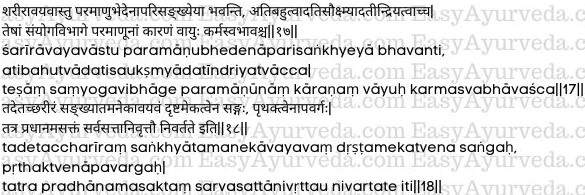
Read – Panchamahabhuta: Application, Areas of Utility in Ayurveda treatment
Innumerability of organs of body
Paramanus are the minute cells / units of the body and they cannot be counted because (1) they are beyond sensory perception. These Paramanus make up the organs of the body. Based on the innumerability of the paramanus, the number of organs of the body is also considered as innumerable. Vayu, the specific nature of the results of the past action and the basic nature associated with these Paramanus are responsible for their union and disjunction. [17]
Knowledge of organs of the body- salvation
When this body composed of various parts is perceived as one unit, this leads to attachment; when the various composing factors are viewed as separate from each other, this leads to salvation. Of the various parts, the Soul is unattached. When He dissociates Himself from all (favourable and unfavourable) manifestations, there is salvation (from the worldly affairs). [18]
Read – Importance Of Soul In Perception Of Knowledge: Atma Jnana
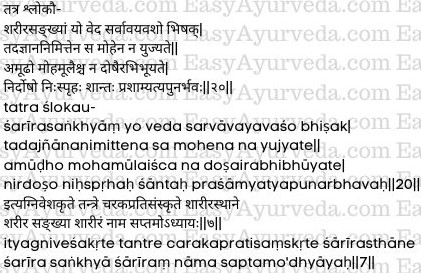
The physician, who knows the number of various components of the body in their entirety, does not associate himself with illusion which is caused by ignorance. Because of the absence of illusion he does not get afflicted with the faults (of such illusion) and being free from faults, he becomes unattached and peaceful which leads to the prevention of his rebirth. [19-20]
Thus ends the seventh chapter of Sharira Section on “The Enumeration of Organs as conducive to the understanding of the human body” of Agnivesha’s work as redacted by Charaka [7]










